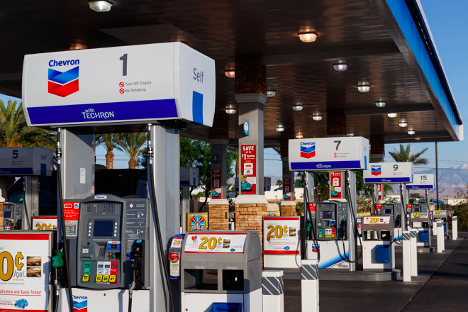Chevron (NYSE: CVX) is a member of the esteemed Dividend Aristocrats. These are companies that are in the S&P 500 and have raised their dividends for 25 years in a row or longer.
It is an esteemed club with only 66 companies included.
Investors love Dividend Aristocrats because they historically beat the market with lower volatility.
Chevron has been in the dividend-raising business since 1988. Back then, we had no cellphones and no internet, but we did still have the Soviet Union. And we were just a year past the 1987 stock market crash. That was a long time ago.
Will Chevron’s dividend be raised for a 34th straight year next year?
Let’s look at the numbers…
Not surprisingly, with oil prices in the teens, free cash flow is expected to plummet this year to $5.5 billion from more than $13 billion a year ago. And it will be just one-third of the total from 2018.
In fact, this year’s free cash flow will likely be Chevron’s lowest since 2016.
 SafetyNet Pro isn’t a fan of declining cash flow. An even bigger infraction is paying out more in dividends than is generated in free cash flow. Chevron checks that box too.
SafetyNet Pro isn’t a fan of declining cash flow. An even bigger infraction is paying out more in dividends than is generated in free cash flow. Chevron checks that box too.
SafetyNet Pro is a groundbreaking tool that predicts dividend cuts with stunning accuracy. With it, you can determine the dividend safety rating of nearly 1,000 stocks. Access to SafetyNet Pro is reserved exclusively for subscribers of Marc’s newsletter, The Oxford Income Letter. To learn more about SafetyNet Pro and The Oxford Income Letter, click here now. |
|
This year, Chevron is projected to pay out $9.8 billion in dividends, nearly twice the amount of free cash flow it will bring in. Last year, the payout ratio was a more sustainable 68%.
It should be noted that prior to the COVID-19 crisis, a 68% payout ratio was considered fine. However, I have made the SafetyNet Pro model more conservative because of the financial devastation that is occurring.
Now, to be comfortable that a dividend is secure, I want to see a payout ratio of 50% or lower. So last year’s 68% is above that new threshold, and the rating falls a notch as a result.
On the plus side, the oil producer has a healthy balance sheet. That’s important for weathering this storm. And that 33-year track record is meaningful.
Last week, on the company’s conference call, CEO Michael Wirth said Chevron’s top financial priority is to protect its dividend. I’m sure shareholders enjoying the current 5.8% yield would agree.
Like AT&T‘s (NYSE: T) rating in last week’s analysis, this stock’s dividend safety rating has slipped – partially because of the new more conservative guideline, but also because of falling cash flow.
While Chevron’s dividend safety rating is low, I don’t necessarily expect a dividend cut this year. However, if free cash flow doesn’t rebound in 2021, the three-decade-plus streak of annual dividend increases could be in jeopardy.
Dividend Safety Rating: D
 If you have a stock whose dividend safety you’d like me to analyze, leave the ticker symbol in the comments section.
If you have a stock whose dividend safety you’d like me to analyze, leave the ticker symbol in the comments section.
Good investing,
Marc
P.S. The Walt Disney Company (NYSE: DIS) just suspended its dividend. And we saw it coming…
SafetyNet Pro had Disney rated an “F” for safety. SafetyNet Pro is a groundbreaking tool that predicts dividend cuts with stunning accuracy. With it, you can determine the dividend safety rating of nearly 1,000 stocks.
With it, you can know which dividends – like Disney’s – to steer clear of.
Access to SafetyNet Pro is reserved for subscribers to my monthly newsletter, The Oxford Income Letter.
If you don’t already have access, you can learn more about SafetyNet Pro and The Oxford Income Letter here.
